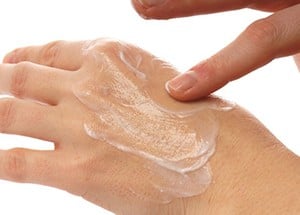
Glycerin (EU) is one of the most important and widely used ingredients in skin care formulations. It is a water-soluble, odorless, colorless, naturally-occurring humectant commonly used as a moisturizer (EU), solvent (EU), or lubricant. Glycerin has over 1500 known uses in different categories that range from foods to urethane foams. About 300 million pounds of glycerin are used annually in the United States, and it is produced by the continuous high-pressure hydrolysis of natural triglyceride-based oils. Glycerin is also naturally occurring in the body and is produced from the metabolism of fats and oils into fatty acids and glycerin.
Glycerin was accidentally discovered in 1779 by K. W. Scheele, a Swedish chemist, while he was heating a mixture of olive oil (EU) and litharge (lead monoxide). Scheele called glycerin the “sweet principle of fat.” Scheele later established that other metals and glycerides produce the same chemical reaction, yielding glycerin and soap. In 1783, he published a description of his method of preparation in the transactions of the Royal Academy of Sweden, and his method was used to produce glycerin commercially for many years.
Glycerin did not become economically or industrially significant until Alfred Nobel invented dynamite in 1866. After twenty years of experimentation, Nobel’s invention successfully stabilized trinitroglycerin, a highly explosive compound, by absorption on kieselguhr, or diatamaceous earth, which permitted safe handling and transportation.
10 Key Benefits
- Excellent moisturizing properties. Most top performing hand and body lotions contain high levels of glycerin.
- Can improve chronic hand dermatitis.
- Can help promote cell exfoliation.
- Can help reduce wound-healing times. Good moisturizers can reduce wound-healing times by up to 25%.
- Glycerin has been shown to stimulate barrier recovery in vivo after repeated skin washing using sodium lauryl sulfate (EU).
- Can help improve the freeze-thaw stability of oil-in-water emulsions.
- Is an approved category 1 OTC skin protectant (>20%).
- Excellent safety profile and low toxicity.
- Natural-based and cost effective.
- Used to produce glycerin-based esters (EU) widely used in personal care formulations as emollients and emulsifiers (polyglyceryl esters (EU), glyceryl stearate (EU), glyceryl tricaprylate/caprate (EU)).
Material Resources in Prospector:
There are more glycerin ingredients in Prospector! View them here… (EU)
The views, opinions and technical analyses presented here are those of the author or advertiser, and are not necessarily those of ULProspector.com or UL Solutions. The appearance of this content in the UL Prospector Knowledge Center does not constitute an endorsement by UL Solutions or its affiliates.
All content is subject to copyright and may not be reproduced without prior authorization from UL Solutions or the content author.
The content has been made available for informational and educational purposes only. While the editors of this site may verify the accuracy of its content from time to time, we assume no responsibility for errors made by the author, editorial staff or any other contributor.
UL Solutions does not make any representations or warranties with respect to the accuracy, applicability, fitness or completeness of the content. UL Solutions does not warrant the performance, effectiveness or applicability of sites listed or linked to in any content.



Hi is humectant glycerol vegan? Because I use ‘extra professional white’ chewingum and there I can see this glycerol. Thank you 🙂
It acts like a antifreeze to depress the freezing point.
It depends whether the feedstock used to produce the Glycerin is Tallow or vegetable oil based.
Is there any palm oil in glyserol